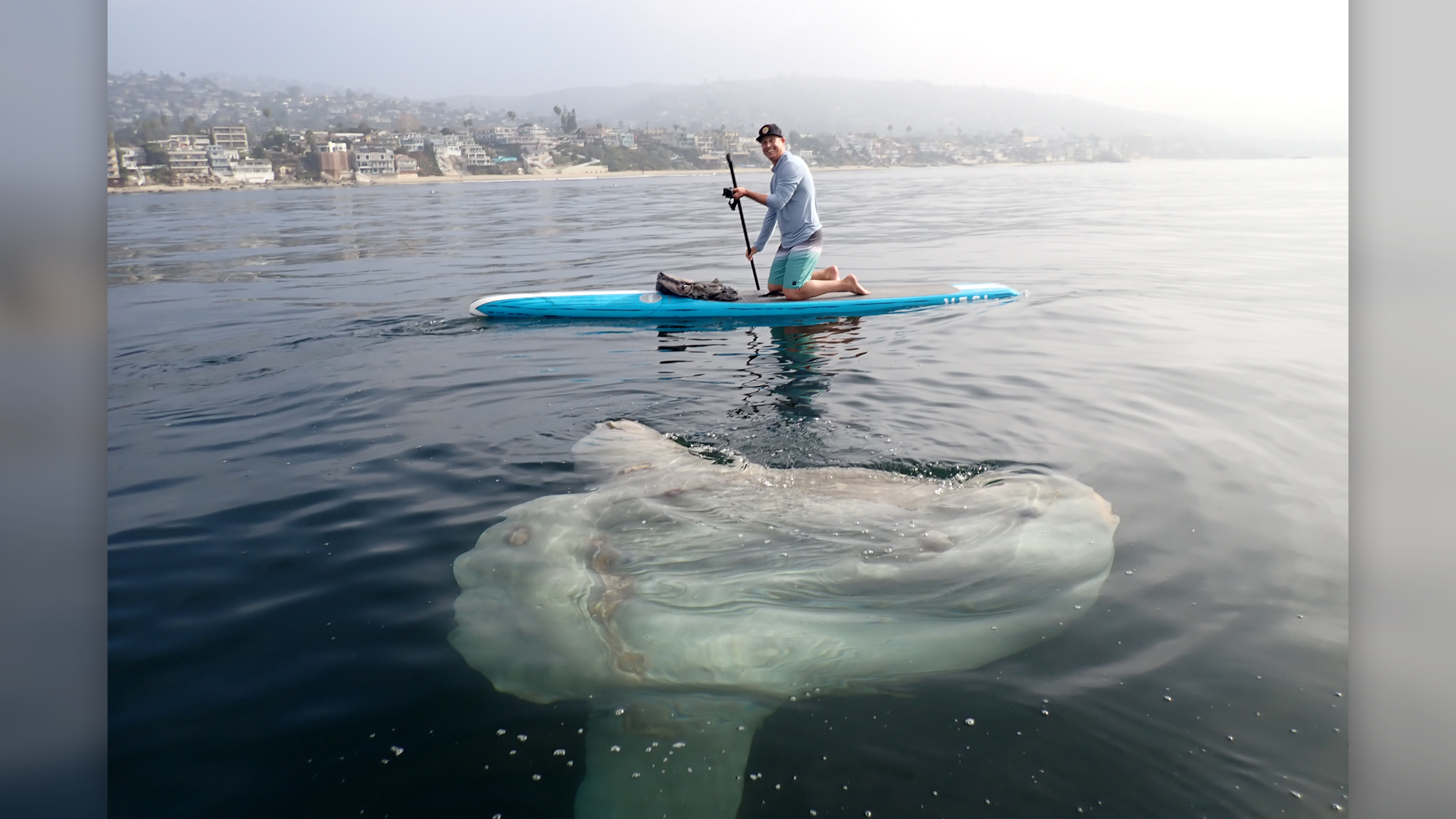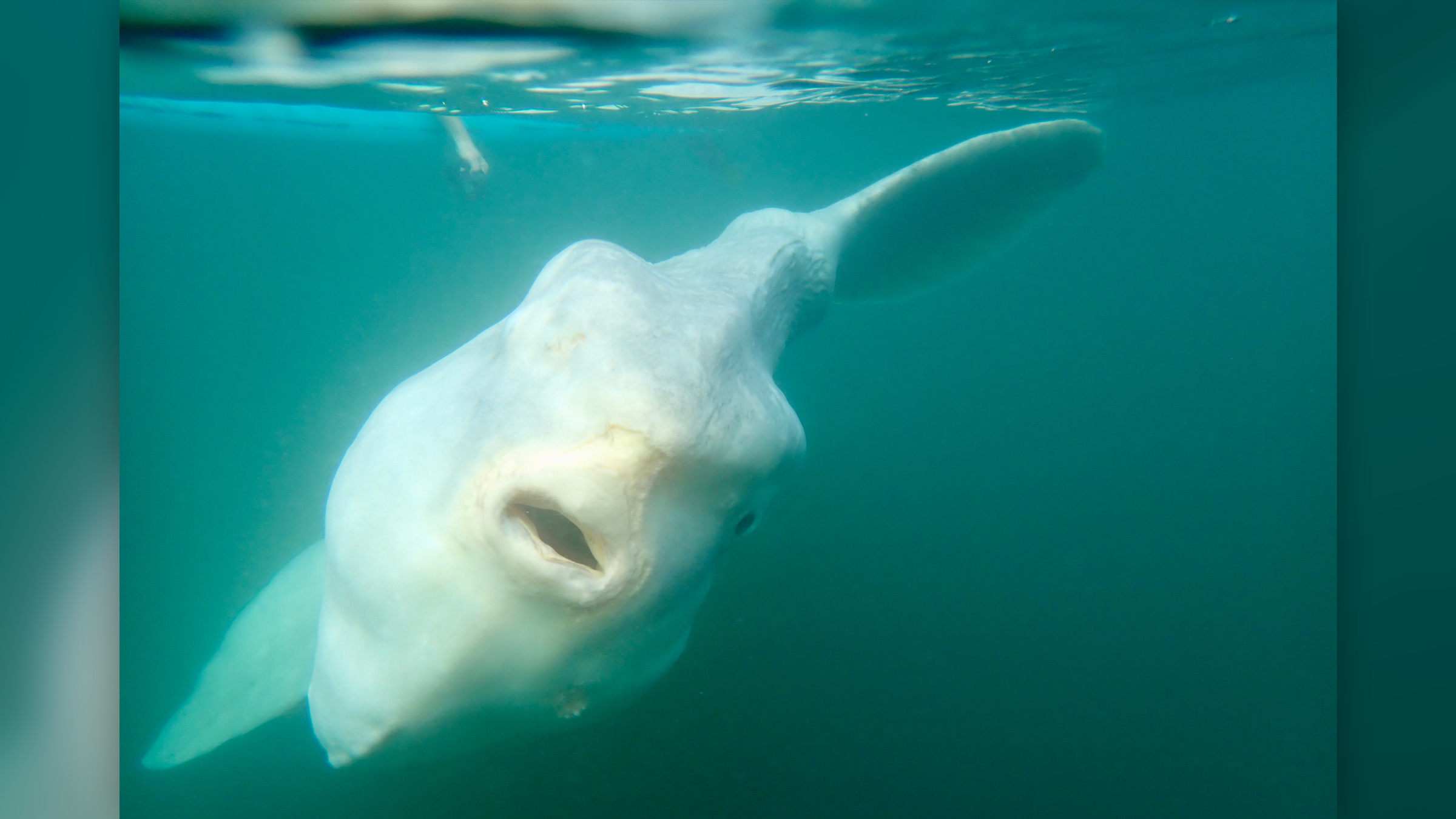Enormous sunfish surprises paddleboarders off Laguna Beach
The absolute unit is about 10 feet long.

A colossal sunfish, possibly one of the largest on record, swam by a pair of paddleboarders in Laguna Beach, California, who "spent a good 30 minutes with the fish before it sank back down," they told Live Science.
The giant fish's dimensions are unknown, but the paddleboard is 14 feet (4.3 meters) long, so judging from the photos, the sunfish was likely 9 to 10 feet (2.7 to 3 m) long, they said. That would be longer than the heaviest bony fish on record: a bump-head sunfish (Mola alexandrini) that measured 8.9 feet (2.7 meters) long and weighed 5,070 pounds (2,300 kilograms) when it was caught off the coast of Japan in 1996, according to Guinness World Records.
However, the Laguna Beach sunfish is not as long as another sunfish celebrity — a jumbo-size M. alexandrini caught off the coast of North Africa in October, Live Science previously reported. That fish measured 10.5 feet (3.2 m) long and weighed 4,400 pounds (2,000 kg), said the fishers, who released it back into the water.
Related: In photos: The world's largest bony fish
Even so, the Dec. 2 encounter with the absolute unit — whose genus name Mola is Latin for "millstone" because the gray fish's color and shape look just like one — was "very cool and unique," said Rich German, one of the paddleboarders, who is the founder of Project O, a nonprofit dedicated to protecting, restoring and sustaining the ocean, and host of the "Our Epic Ocean" podcast.

When they set off, the two paddleboarders, German and his friend Matt Wheaton, hoped to spot dolphins. Instead, when they were about 600 feet (180 m) off a long and popular stretch of Main Beach, they "stumbled" upon the sunfish, German told Live Science in an email. "I've seen them many times so I knew what it was, but typically they are much farther offshore and not this big."

The fish was likely a common mola, also known as the ocean mola (M. mola), German said. These fish live in temperate and tropical waters and are known to swim around coastal California, according to iNaturalist. That said, other sunfish species have turned up in California, including a very lost Mola tecta, which is nicknamed the "hoodwinker" because it is so rarely seen even in its usual home in the Southern Hemisphere, Live Science previously reported.
Sign up for the Live Science daily newsletter now
Get the world’s most fascinating discoveries delivered straight to your inbox.
Although not as heavy as M. alexandrini, the common mola is still a chunk, weighing between 545 and 4,409 pounds (247 and 2,000 kg), according to iNaturalist. M. mola eats all types of marine prey, including small fishes, fish larvae, squid and crustaceans; less common meals include sea jellies and salps.
Female sunfish can lay up to 300 million eggs at a time, the most of any known vertebrate species, iNaturalist reported. Unlike their enormous parents, sunfish fry are minuscule, spanning just a few millimeters in length. The size difference between the two is so immense, scientists had to sequence the DNA of both to verify they were the same species, Live Science previously reported.
Once they grow up, sunfish are known for their big, startled-looking eyes, huge heads and tall back fin, which is sometimes mistaken for a shark's dorsal fin when they swim to the water's surface. "The first time I saw one, I had no idea what it was," German said. "It looks like a mutilated shark that got cut in half."
Sunfish are vulnerable to sea lions, orcas and sharks, but overfishing and bycatch, or unintentionally caught fish, have been the main culprit of declining numbers, which is why the International Union for Conservation of Nature lists the common mola as "vulnerable." As for the huge sunfish that happened across the paddleboarders, "it happened within Laguna's marine protected no-take zone where it is illegal to fish, so this guy was safe here," German said.
Originally published on Live Science.

Laura is the archaeology and Life's Little Mysteries editor at Live Science. She also reports on general science, including paleontology. Her work has appeared in The New York Times, Scholastic, Popular Science and Spectrum, a site on autism research. She has won multiple awards from the Society of Professional Journalists and the Washington Newspaper Publishers Association for her reporting at a weekly newspaper near Seattle. Laura holds a bachelor's degree in English literature and psychology from Washington University in St. Louis and a master's degree in science writing from NYU.










